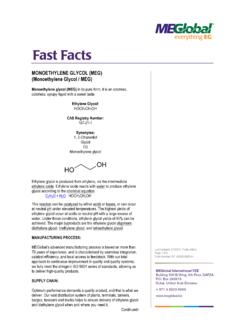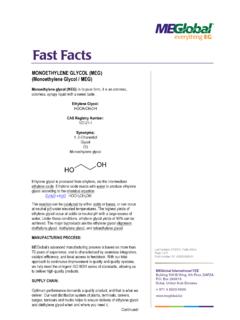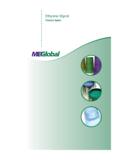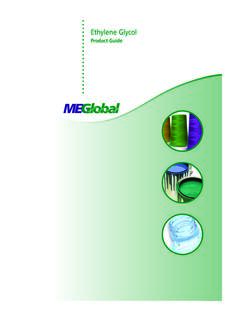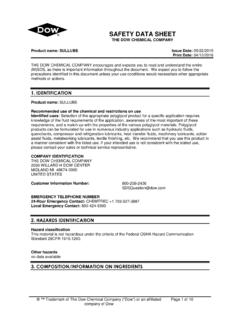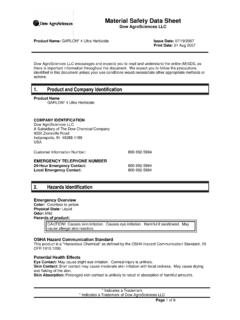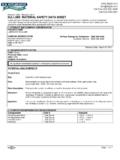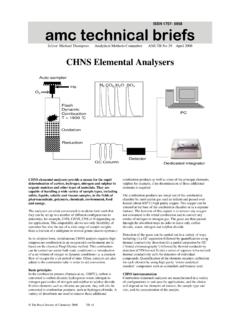Transcription of Material Safety Data Sheet - MEGlobal
1 Product Name:ETHYLENE GLYCOL POLYESTER GRADEI ssue Date:11/21/2013 Print Date:13 Dec 2013 (TM)*TrademarkPage1 of 9 MEGlobal Americas and expects you to read and understand the entire (M)SDS, asthere is important information throughout the document. We expect you to follow the precautionsidentified in this document unless your use conditions would necessitate other appropriate methods and Company IdentificationProduct NameETHYLENE GLYCOL POLYESTER GRADECOMPANY IDENTIFICATIONMEG lobal Americas 1003320 Ridgecrest DriveMidland, MI 48642 United StatesCustomer Information TELEPHONENUMBER24-Hour Emergency Contact:989-636-4400 Local Emergency IdentificationEmergency OverviewColor:ColorlessPhysical :SweetHazards of product:WARNING! Harmful or fatal if swallowed. May cause eye irritation. Isolate Hazard Communication StandardThis product is a Hazardous Chemical as defined by the OSHA Hazard Communication Standard, 29 CFR Health EffectsEye Contact:May cause slight eye irritation.
2 Corneal injury is unlikely. Vapor or mist may cause Contact:Brief contact is essentially nonirritating to skin. Prolonged contact may cause slightskin irritation with local redness. Repeated contact may cause skin irritation with local Safety data SheetMEGlobal Americas Name:ETHYLENE GLYCOL POLYESTER GRADEI ssue Date:11/21/2013 Page2 of 9 Skin Absorption:Prolonged skin contact is unlikely to result in absorption of harmful skin exposure to large quantities may result in absorption of harmful amounts. Massivecontact with damaged skin or of Material sufficiently hot to burn skin may result in absorption ofpotentially lethal :At room temperature, exposure to vapor is minimal due to low volatility. With goodventilation, single exposure is not expected to cause adverse effects. If Material is heated or areas arepoorly ventilated, vapor/mist may accumulate and cause respiratory irritation and symptoms such asheadache and :Oral toxicity is expected to be moderate in humans due to ethylene glycol even thoughtests with animals show a lower degree of toxicity.
3 Ingestion of quantities (approximately 65 mL (2 oz.)for diethylene glycol or 100 mL (3 oz.) for ethylene glycol) has caused death in humans. May causenausea and vomiting. May cause abdominal discomfort or diarrhea. Excessive exposure may causecentral nervous system effects, cardiopulmonary effects (metabolic acidosis), and kidney hazard:Based on physical properties, not likely to be an aspiration of Repeated Exposure:Observations in humans include: Nystagmus (involuntary eyemovement). In animals, effects have been reported on the following organs: Kidney. Defects/Developmental Effects:Based on animal studies, ingestion of very large amounts ofethylene glycol appears to be the major and possibly only route of exposure to produce birth by inhalation or skin contact, the primary routes of occupational exposure, had minimaleffect on the fetus, in animal Effects:Ingestion of large amounts of ethylene glycol has been shown to interfere withreproduction in #AmountEthylene glycol107-21-1> measuresDescription of first aid measuresGeneral advice:First Aid responders should pay attention to self-protection and use therecommended protective clothing (chemical resistant gloves, splash protection).
4 If potential forexposure exists refer to Section 8 for specific personal protective :Move person to fresh air; if effects occur, consult a Contact:Immediately flush skin with water while removing contaminated clothing and shoes. Getmedical attention if symptoms occur. Wash clothing before reuse. Destroy contaminated leather itemssuch as shoes, belts, and watchbands. Suitable emergency Safety shower facility should beimmediately Contact:Flush eyes thoroughly with water for several minutes. Remove contact lenses after theinitial 1-2 minutes and continue flushing for several additional minutes. If effects occur, consult aphysician, preferably an :Do not induce vomiting. Seek medical attention immediately. If person is fully consciousgive 1 cup or 8 ounces (240 ml) of water. If medical advice is delayed and if an adult has swallowedseveral ounces of chemical, then give 3-4 ounces (1/3-1/2 Cup) (90-120 ml) of hard liquor such as 80proof whiskey.
5 For children, give proportionally less liquor at a dose of ounce (1 tsp.) (8 ml)liquor for each 10 pounds of body weight, or 2 ml per kg body weight [ , ounce (2 1/3 tbsp.) for a40 pound child or 36 ml for an 18 kg child].Most important symptoms and effects, both acute and delayedAside from the information found under Description of first aid measures (above) and Indication ofimmediate medical attention and special treatment needed (below), no additional symptoms andeffects are of immediate medical attention and special treatment neededIf several ounces (60 - 100 ml) of ethylene glycol have been ingested, early administration of ethanolmay counter the toxic effects (metabolic acidosis, renal damage). Consider hemodialysis or peritonealdialysis & thiamine 100 mg plus pyridoxine 50 mg intravenously every 6 hours.
6 If ethanol is used, InformationProduct Name:ETHYLENE GLYCOL POLYESTER GRADEI ssue Date:11/21/2013 Page3 of 9therapeutically effective blood concentration in the range of 100 - 150 mg/dl may be achieved by arapid loading dose followed by a continuous intravenous infusion. Consult standard literature fordetails of treatment. 4-Methyl pyrazole (Antizol ) is an effective blocker of alcohol dehydrogenaseand should be used in the treatment of ethylene glycol (EG), di- or triethylene glycol (DEG, TEG),ethylene glycol butyl ether (EGBE), or methanol intoxication if available. Fomepizole protocol (Brent,J. et al., New England Journal of Medicine, Feb. 8, 2001, 344:6, p. 424-9): loading dose 15 mg/kgintravenously, follow by bolus dose of 10 mg/kg every 12 hours; after 48 hours, increase bolus dose to15 mg/kg every 12 hours.
7 Continue fomepizole until serum methanol, EG, DEG, TEG or EGBE areundetectable. The signs and symptoms of poisoning include anion gap metabolic acidosis, CNSdepression, renal tubular injury, and possible late stage cranial nerve involvement. Respiratorysymptoms, including pulmonary edema, may be delayed. Persons receiving significant exposureshould be observed 24-48 hours for signs of respiratory distress. In severe poisoning, respiratorysupport with mechanical ventilation and positive end expiratory pressure may be required. Maintainadequate ventilation and oxygenation of the patient. If lavage is performed, suggest endotrachealand/or esophageal control. Danger from lung aspiration must be weighed against toxicity whenconsidering emptying the stomach. If burn is present, treat as any thermal burn, afterdecontamination.
8 Treatment of exposure should be directed at the control of symptoms and theclinical condition of the Fighting MeasuresSuitable extinguishing mediaWater fog or fine spray. Dry chemical fire extinguishers. Carbon dioxide fire extinguishers. resistant foams (ATC type) are preferred. General purpose synthetic foams (including AFFF)or protein foams may function, but will be less Media to Avoid:Do not use direct water stream. May spread hazards arising from the substance or mixtureHazardous Combustion Products:During a fire, smoke may contain the original Material in additionto combustion products of varying composition which may be toxic and/or irritating. Combustionproducts may include and are not limited to: Carbon monoxide. Carbon dioxide. Nitrogen Fire and Explosion Hazards:Container may rupture from gas generation in a fire steam generation or eruption may occur upon application of direct water stream to hot for firefightersFire Fighting Procedures:Keep people away.
9 Isolate fire and deny unnecessary entry. Use waterspray to cool fire exposed containers and fire affected zone until fire is out and danger of reignition haspassed. Fight fire from protected location or safe distance. Consider the use of unmanned hoseholders or monitor nozzles. Immediately withdraw all personnel from the area in case of rising soundfrom venting Safety device or discoloration of the container. Burning liquids may be extinguished bydilution with water. Do not use direct water stream. May spread fire. Move container from fire area ifthis is possible without hazard. Burning liquids may be moved by flushing with water to protectpersonnel and minimize property Protective Equipment for Firefighters:Wear positive-pressure self-contained breathingapparatus (SCBA) and protective fire fighting clothing (includes fire fighting helmet, coat, trousers,boots, and gloves).
10 If protective equipment is not available or not used, fight fire from a protectedlocation or safe Release MeasuresPersonal precautions, protective equipment and emergency procedures:Isolate area. Keepunnecessary and unprotected personnel from entering the area. Refer to Section 7, Handling, foradditional precautionary measures. Use appropriate Safety equipment. For additional information,refer to Section 8, Exposure Controls and Personal precautions:Prevent from entering into soil, ditches, sewers, waterways and/orgroundwater. See Section 12, Ecological and materials for containment and cleaning up:Contain spilled Material if in suitable and properly labeled containers. Small spills: Absorb with materials such as: CatProduct Name:ETHYLENE GLYCOL POLYESTER GRADEI ssue Date:11/21/2013 Page4 of 9litter.
